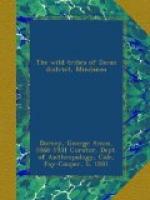and is later boiled with the dye for a half hour,
after which it is placed in a basket to drain and
dry. The process is repeated daily for about two
weeks, or until the thread assumes a brick red color.
If a purple hue is desired a little lime is added
to the dye. Black is obtained by a slightly different
method. The leaves, root, and bark of the
pinarrEm
tree are crushed in water. This yields a black
liquor which is poured into a jar containing the thread
and the whole is placed over a slow fire where it
remains until the liquid is near the boiling point.
When this is reached the thread is removed and placed
in a gourd, the open end of which fits over the jar
so as to catch the steam coming from the dye.
After a time the thread is removed and dried, and the
process is repeated until at last a permanent black
is obtained. After the coloring is complete the
thread is again placed on the rectangular frame, the
over-tying is removed and the warp is ready for the
loom (Plate XXII.) In the loom (Plate XXIII) the threads
encircle a bamboo pole attached to the wall, and are
held tense by a strap which passes around the waist
of the operator. The weft threads are forced
up against the fabric by means of the comber board
and are beaten in with a baton. The warp threads
are held in their relative positions, first by the
comber board, second by loops which pass under the
lower threads and over a small stick or lease rod,
and lastly by passing over and under, or around, other
lease rods. These are rolled away as the work
progresses.
[1] Morinda Bracteata Roxb.
[2] Woof threads are generally of one color.
A somewhat similar process used in Java is described
by SIR THOS. RAFFLES in The History of Java,
Vol. I, p. 189.
[Transcriber’s note: Although footnote
2 appears on the same page as the above paragraph,
it is not clear to what particular part of that paragraph
it refers.]
After the cloth is removed from the loom it is polished.
A long pole of palma brava is fitted into a
notch in the roof. The operator seats herself
on the floor with a smooth board before her, or in
her lap, and on it places the dampened cloth.
A shell is fitted over the lower end of the pole,
which is bent and made bowlike, until the shell rests
on the cloth. It is then ironed rapidly to and
fro until the fabric has received a high polish (Plate
XXIV).
The woman’s duties do not end with the manufacture
of cloth, for all the garments worn by the members
of the tribe are the result of her handiwork.
She sews the strips of hemp cloth into skirts, men’s
trousers, carrying bags, and sometimes into jackets.
The women devote hours of labor to these jackets,
covering arms, necks, and waist bands with colored
embroidery or designs in applique, while on the better
garments they place elaborate designs in beads or shell
disks.
After the evening meal is over the women of the household
gather around the flickering lights, and until far
into the night work on these garments, bead necklaces,
or other ornaments.




